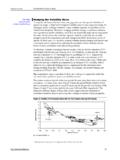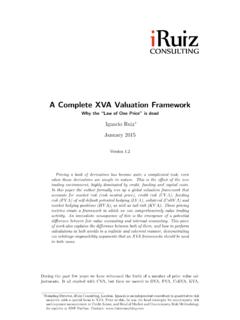Transcription of Relative Valuation of U.S. Insurance Companies
1 Relative Valuation of Insurance Companies +. Doron Nissim*. Columbia Business School December 2011. Abstract This study examines the accuracy of Relative Valuation methods in the Insurance industry, using price as a proxy for intrinsic value. The approaches differ in terms of the fundamentals used, the adjustments made to the fundamentals, the use of conditioning variables, and the selection of comparables. The primary findings are as follows: Unlike for non-financial firms, book value multiples perform relatively well in valuing Insurance Companies and are not dominated by earnings multiples. In fact, over the last decade book value multiples have performed significantly better than earnings multiples. That is, estimated values calculated as the product of book value and the average price-to-book ratio of comparable insurers are generally closer to price than are similarly-calculated earnings-based value estimates. Inconsistent with the practice of many Insurance analysts, excluding Accumulated Other Comprehensive Income (AOCI) from book value worsens rather than improves Valuation accuracy.
2 As expected, using income before special items instead of reported income improves Valuation accuracy, but, surprisingly, excluding realized investment gains and losses does not. An exception to this latter result occurred during the financial crisis, likely due to an increase in gains trading . activities. Conditioning the price-to-book ratio on ROE significantly improves the Valuation accuracy of book value multiples. In contrast, incorporating proxies for growth, earnings quality and risk does not consistently improve out-of-sample predictions, although these determinants of the price-to-book ratio generally have the expected effects and are significant. Limiting peers to the same sub-industry (as opposed to all Insurance Companies ) improves Valuation accuracy. Adjusting with respect to potentially dilutive shares improves earnings-based valuations but not book value-based valuations. As expected, valuations based on analysts' earnings forecasts outperform those based on reported earnings or book value.
3 However, the gap between the Valuation performance of forecasted EPS. and the conditional price-to-book approach was relatively small during the last decade. +. Forthcoming in the Review of Accounting Studies. *. 604 Uris Hall, 3022 Broadway, New York, NY 10027; phone: (212) 854-4249; The author gratefully acknowledges the helpful comments and suggestions made by Andrew Alford, Mary Barth, Bill Beaver, Patrick Bolton, Trevor Harris, Gur Huberman, Jack Hughes, Urooj Khan, Maureen McNichols, Jim Ohlson (the editor), Stephen Penman, Joseph Piotroski, Harold Schroeder, Leslie Seidman, an anonymous reviewer, and seminar participants at the CARE-CEASA Conference on Accounting for Uncertainty and Risk, Columbia Business School (accounting and finance workshops), the Danish Center for Accounting and Finance Fifth Interdisciplinary Accounting Conference, the Financial Accounting Standards Board, Stanford University, and UCLA. This research was partially sponsored by the Center for Excellence in Accounting and Security Analysis (CEASA).
4 1. Introduction Two alternative approaches are generally used in estimating equity value: fundamental Valuation and Relative Valuation . Fundamental Valuation involves discounting expected values of fundamentals such as free cash flow, dividends or residual income, while Relative Valuation specifies the value of the firm as a function of selected fundamentals and their average pricing for peer Companies . This study examines the accuracy of Relative Valuation methods in the Insurance industry, using price as a proxy for intrinsic value. Stated differently, the study compares the ability of alternative Valuation methods to explain observed prices, with the objective of gaining a better understanding of how investors value Insurance Companies . Relative Valuation is typically implemented with price multiples, that is, by multiplying a firm's fundamental by the average price-to-fundamental ratio for a group of similar Companies (same industry, size, leverage, etc.). The average multiple is calculated using location measures such as the mean, median or harmonic mean, and often reflects discretionary adjustments made to account for differences in relevant value drivers ( , growth, risk, payout, earnings quality).
5 Across the Companies . Another Relative Valuation approach, which is less common, is to use conditional price multiples (hereafter conditional Valuation ). This approach explicitly adjusts observed multiples ( , the price-to-book ratio) for differences in relevant value drivers ( , return on equity or ROE). In effect, conditional Valuation is the multivariate counterpart of price multiple Valuation it is based on the same rationale as price multiples but uses several fundamentals simultaneously. 1. Academic research and teaching emphasize fundamental Valuation models, although in practice they are much less common than price multiple Recognizing this gap, recent research has examined the Valuation performance of various price These studies generally calculate multiples within industries but evaluate their performance across all Companies in the cross section. Importantly, prior research typically does not adjust the fundamentals or Valuation approach for industry-specific factors or This is unfortunate because industry-specific adjustments often have significant effects and are accordingly emphasized by analysts.
6 This study examines the impact of industry-specific adjustments on the estimated values of Insurance An examination of analysts' reports reveals three primary differences between the reports of analysts that follow Insurance Companies (hereafter Insurance analysts' reports ) and those of other analysts. First, price multiples based on the book value of equity are almost always included in the Valuation section of Insurance analysts' reports but are uncommon in other reports. Second, conditional price multiples primarily price-to-book ratio conditioned on ROE are often used in the Insurance and banking industries but are rarely used outside the 1. Asquith et al. (2005) analyze a sample of 1,126 analyst reports written during the years 1997-1999 (56 sell-side analysts, 11 investment banks, 46 industries). They find that in of the reports the analysts mention that they use some sort of earnings multiple ( , a price-to-earnings ratio, EBITDA multiple, Relative price-to-earnings ratio).
7 In contrast, only in ( ) of the reports the analysts cite using any variation of discounted cash flow Valuation (asset multiple). Very few analysts use alternative Valuation methodologies. All analysts who mention a Valuation method use an earnings multiple; that is, the that do not mention an earnings multiple do not mention any Valuation method. 2. For example, Alford (1992), Bhattacharya et al. (2003), Bhojraj and Lee (2002), Bhojraj et al. (2003), Gilson et al. (2000), Kim and Ritter (1999), Lie and Lie (2002), Liu et al. (2002, 2007), and Yee (2004). 3. One exception is Calomiris and Nissim (2007), who develop and estimate a conditional Relative Valuation model for bank holding Companies . 4. In addition to (1) potential improvements from using industry-specific models and factors and (2) consistency with practice, industry-specific research offers the following advantages: (3) model stability (control for unmodeled factors that correlate with industry membership), (4) industry-specific research questions and insights, and (5) ability to conduct contextual analysis.
8 2. financial sector. Third, unique to the Insurance industry, analysts often exclude Accumulated Other Comprehensive Income (AOCI) from book value when measuring ROE and the price-to- book ratio. The current study empirically evaluates the validity of the motivations underlying these choices. In most industries, some form of an earnings construct is considered the primary value driver. In contrast, for Insurance Companies the book value of equity appears to play an equally important role to that of earnings. This is due to several reasons, including the financial nature of most assets and liabilities of Insurance Companies , the relatively small size of unrecognized intangibles, and the role of regulatory capital. Still, book value cannot fully capture intrinsic equity value. In particular, it does not reflect the value associated with unrecognized relationship assets and fee-generating activities, which for some insurers are significant. Fortunately, the value impact of these assets and activities is reflected in earnings.
9 Thus, a Valuation method that simultaneously extracts information from both book value and earnings should be preferable to univariate price multiples. Conditional Valuation represents one such approach. By conditioning the price-to-book ratio on ROE and possibly other relevant characteristics, the resulting Valuation reflects earnings in addition to book value. On the negative side, conditional Valuation may be difficult to implement as it requires one to identify the relevant conditioning variables and to specify and estimate their effects. In particular, conditioning variables may be measured with error, their effects may be non-linear, and their inclusion in the model may reduce precision due to the increase in the number of estimated parameters. Therefore, whether conditional Valuation performs better than price multiple Valuation in valuing Insurance Companies is an open question, which this study addresses. 3. Insurance analysts exclude AOCI from book value to reduce the volatility of book value and mitigate accounting distortions.
10 Because Insurance Companies report most investments at fair value, their book value is highly volatile at times of market dislocation such as the 2007-2009. financial crisis. In contrast, ex-AOCI book value is less sensitive to such fluctuations because it excludes unrealized investment gains and losses. Therefore, focusing on ex-AOCI book value allows analysts to use an arguably more representative measure of equity investment, similar to the use of core or recurring earnings instead of net income. Relatedly, excluding AOCI from book value mitigates distortions caused by the mixed attributes model historical cost and fair value used under current GAAP. This follows because the reserve liabilities that the investments are expected to fund and whose value is correlated with that of the investments (both are interest rate sensitive) are generally not marked to market. Thus, unrealized investment gains and losses cause an artificial volatility in AOCI and book value. Yet, excluding AOCI from book value may be problematic.















